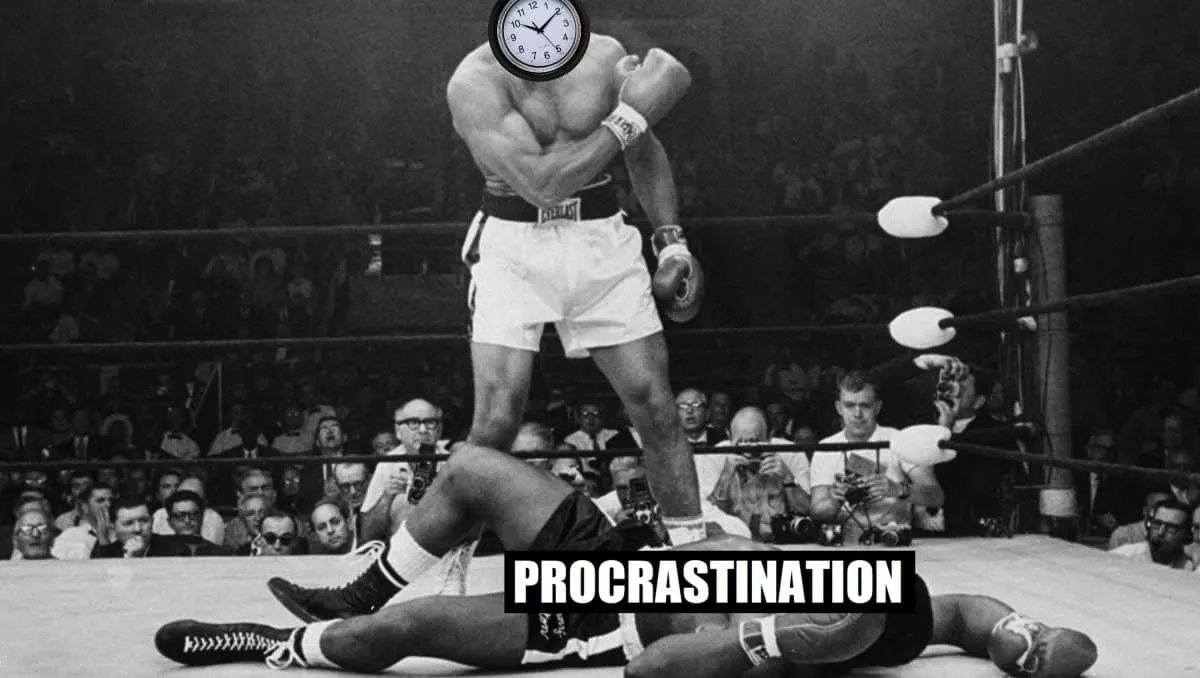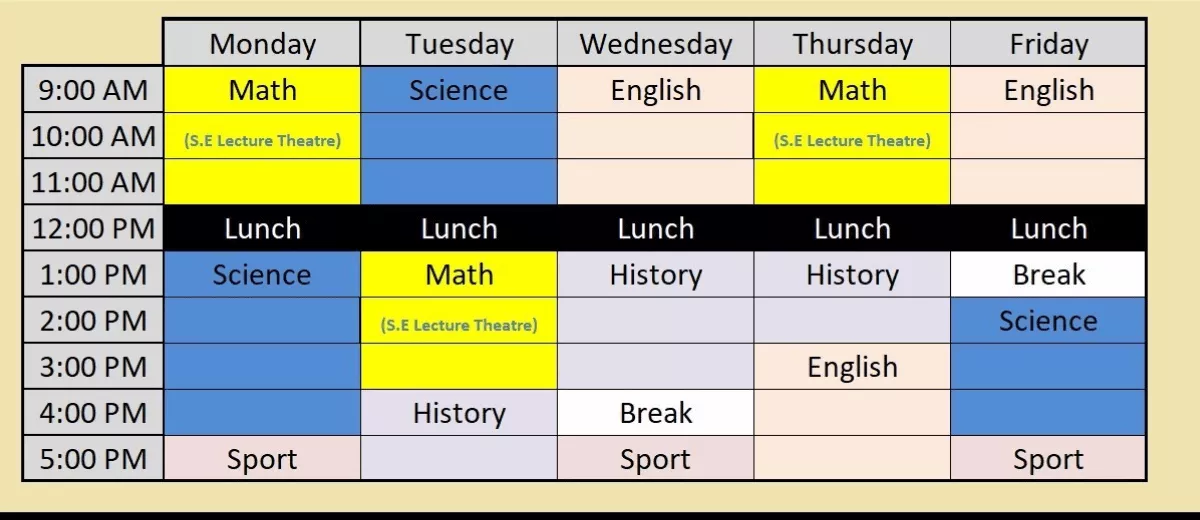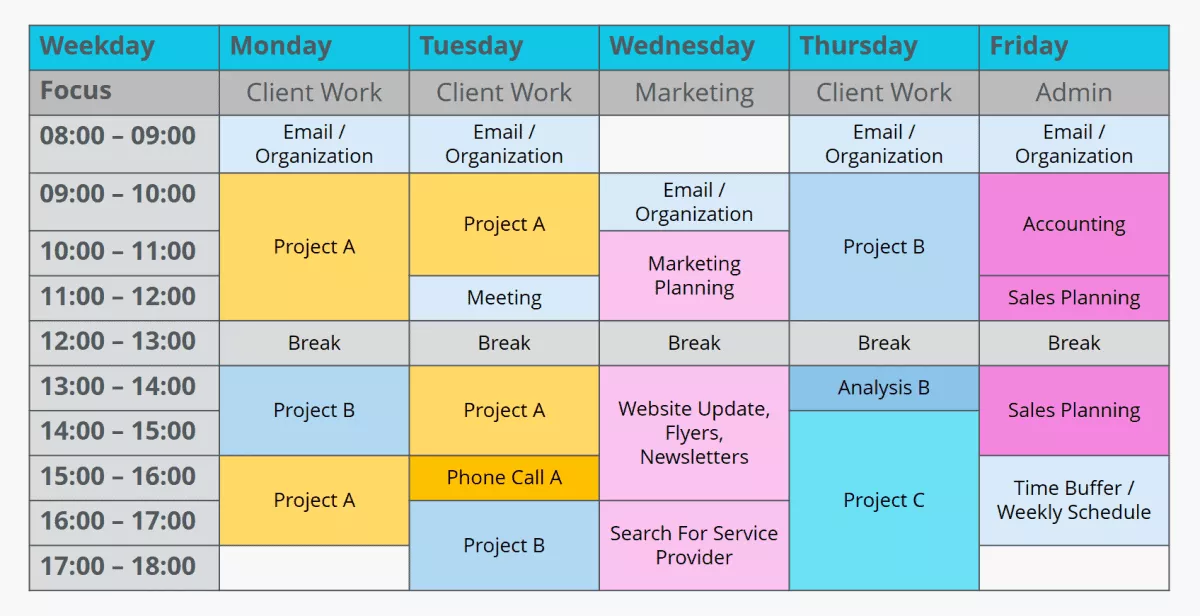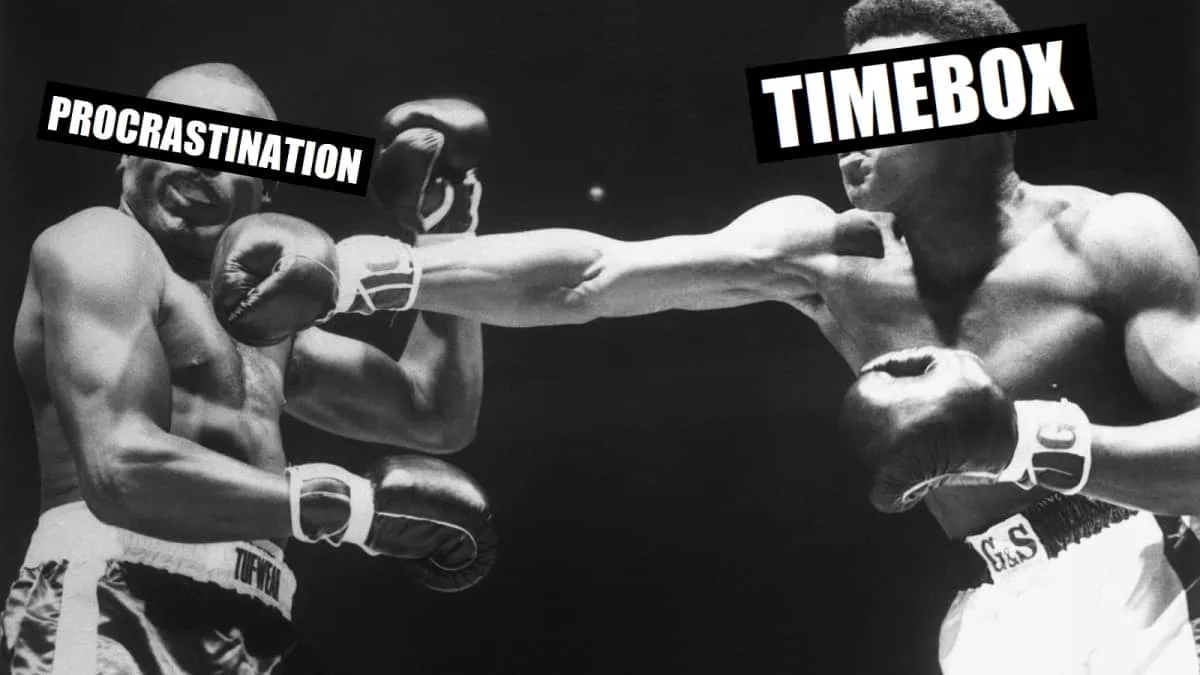
Timeboxing might sound like something fancy, but it’s actually quite simple. Even if you’re not familiar with it, you’ve most likely done it subconsciously.
In a profession where timing is super flexible, timeboxing is one of the most beneficial strategies freelancers can use to stay focused and stay ahead.
So what is this magical strategy? How have you done it before? And how does it supercharge your productivity?
Do you remember those timetables we had in school that helped us keep track of class schedules?
They kinda looked like this…

Generally speaking, timeboxing works the same way, except in adult form. It’s a super simple but highly effective tool for productivity.
Going into the specifics of how exactly timeboxing works, you open your calendar and enter a block of time that you’ll spend on a certain task. Instead of working on the task until it’s done, you proactively decide how much time you’ll spend on it.
For example, scheduling a video call meeting. You select the day, start and finish hours, define the desired outcome, and allocate a time for it in your calendar.
Once you’ve reserved a timebox, treat it like an important scheduled meeting. That means no rescheduling, no distractions during the process, etc. That timebox is solely dedicated to accomplishing the task at hand.
For projects or other bigger tasks, you can reserve several blocks of time in advance. By doing so, you have full control over your schedule and priorities.
Here’s how a freelancer’s timebox generally looks.

“Oh yeah? How’s this middle-schooler nonsense going to help me?” – you may be wondering.
Well, first of all, studies show that out of 100 productivity tools, timeboxing actually ranks number one. It’s so effective you could call it a productivity hack!
The main benefits that make timeboxing the reigning champion of productivity tools are…
Timeboxing prevents the risk of low quality work due to overthinking and overdoing. By doing this, you’re also preventing yourself from going over project deadlines.
Now, you’re probably wondering why it’s so effective. How does such a simple method become the top productivity tool with so many benefits?
You can accredit timeboxing’s effectiveness to a psychological phenomena called Parkinson’s Law.
It sounds kind of confusing at first, but here let me paint you a scenario.
You have 1 week to do a project, let’s say writing an article. The first few days, you’re preparing materials. Doing extensive research. Sourcing for works to take inspiration and cite.
By the time you’ve fully prepared to sit down and get the article done, the deadline is tomorrow. Of course, you submit your work before the deadline.
Now what if your deadline was tomorrow itself? You’d still do anything necessary to submit it, and you succeed.
Both scenarios, you’ve done the same amount of work, the only difference is the time taken to do it.
With the same project, the work expanded to fill the time allotted for it. {Mindblown!}
But that’s not all. Parkinson’s law doesn’t just apply to projects, it affects almost everything that you do.
For example, cleaning your workspace. If you didn’t set a timebox, chances are you’d look around at all the mess, become overwhelmed, and then procras-tinate by grabbing another drink to sit down and look at the mess again. You may restart, then get distracted by your phone.
However, if you only had 15 minutes for the task, it’s much easier to buckle down and get some hardcore progress going.
A quote by Joel Falconer to sum it up:
“Okay fine, you got me. So how do I make one? Do I just slap on whatever tasks I have on my calendar and call it a day?”
Yes and no. That’s how you can make a generic “meh” timebox. I’ll give you 5 steps on making a great one!
Generally, you can timebox any task you want, but to make timeboxing shine, it’s best to identify and select important tasks.
I say the most important tasks are the ones you have no motivation to do and the ones that you don’t want to spend much time doing.
For the former, usually those tasks are things like long and tedious projects you’ve chosen to procrastinate on for the longest time.
By dividing projects like this into smaller, manageable chunks with their own separate deadlines and milestones, you’re making the task less daunting for yourself. You are literally (metaphorically?) breaking down a giant cookie so you don’t bite off more than you can chew.
For the latter, these tasks are usually necessary but unpleasant to do. E.g., household chores or sending a difficult email.
By setting a strict deadline for such work, you’re limiting the time you’ll spend on them right from the start.
Once you’ve decided your important tasks, you need to decide what you want to accomplish with them, and when.
For example, if you’re working on a 20,000 word writing contract, and you have a month to finish it, your goal for the project is clear: write a thought-provoking paper before the month is over.
Right now, that’ll be your castle in the sky. To get there, you’ll need to create the stairway by breaking the goal into smaller steps.
To get to your ultimate goal, you’ll need to write about 800 words per day. Which is extremely realistic and doable.
Let me explain.
So let’s say your deadline is 30 days from now. Ideally you’d want at least 5 days of leeway to be prepared for unexpected situations that might mess with your schedule. By writing 800 words per day you’ll finish it in 25 days (800 * 25 = 20000).
You’re able to chip away at long projects by defining your goals and breaking them up into manageable timeboxes.

On the other hand, when it comes to the necessary tasks you lack the motivation to do, you can make working on said task during a timebox a goal in itself.
For example, make cleaning up your room for 10 minutes your sole goal. You can even have a daily timebox for this.
Work on the task for a straight whole week and by the end of it all you’ll realize you’ve made great progress without even breaking a sweat.
Not a lot to explain, once you’ve broken down and zeroed in on your goals to hit, it’s time to decide when to do it.
Decide when you’re going to start and end the task. Ideally, timeboxing works best at short intervals throughout the day.
Sticking with the writing example, so 800 words per day. You could split it into 200 words into 4 timeboxes of 15-30 minutes throughout the day. When you look at it that way, the huge project becomes even more of a series of menial tasks.
Fun fact, Anthony Trollope wrote over 60 novels and many plays in his life with this exact strategy.
Now that everything’s in order, it’s pretty much the last and easiest step (with a catch). As Nike says, Just Do It!
To make sure you’re on track, use a timer to time yourself.
Okay, here’s the catch,
You need to completely and utterly focus on that task for the duration of the timeblock. Absolutely zero distractions.
Once your time is up, stop working immediately, then review your results. You need to determine if the timebox was good for you, and if there is tweaking needed to be done.
Within those 15-30 minutes, did you write 200 words? Were they thought provoking, or drivel on the page to hit the word count limit?
Could you have done better if the time was longer/shorter? Maybe less but bigger timeboxes would help? Did you have any distractions?
Each time you work on your task during the preset time period, you’re timeboxing successfully. After each timebox, you have to go mentally go through it to find out how effective it was, and if there are ways for you to make it even more effective.
This is an optional step, but I think this’ll supercharge your timeboxing efficiency while making it a fun process.
It has something to do with increasing the serotonin in our brains, providing constant motivation. Check out my gamification article if you want to know more in-depth details!
Anyway, after you’ve done your tasks and completed your timebox, give yourself a reward. Watch Netflix, eat some chocolate, play some music. Whatever floats your goat and makes you happy!

The (scientifically proven) best productivity tool is something simple but powerful.
Timeboxing is the perfect tool for any freelancer to make even the most daunting contracts seem like a chain of small easy tasks. You simply break things up into manageable pieces and follow a disciplined schedule of when to do them.
By incorporating this strategy to your career, you’re able to not only be more efficient, but also prevent a lot of stress from overloading yourself.
David is a content creator and freelancer. His journey started with writing songs, poetry and academic dissertations in Vancouver. David has freelanced for multiple companies around the world. Feel free to connect with him on LinkedIn.